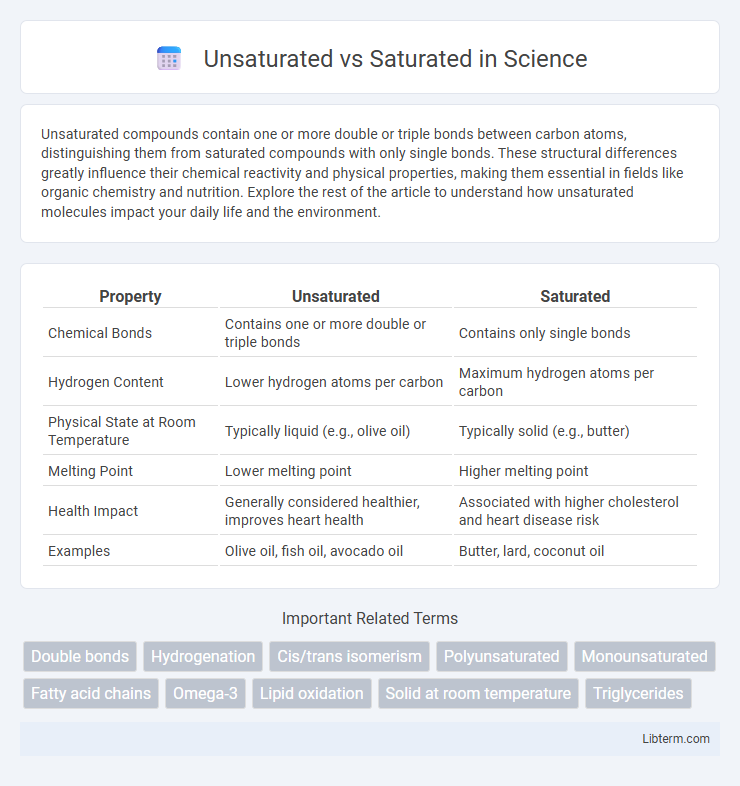Unsaturated compounds contain one or more double or triple bonds between carbon atoms, distinguishing them from saturated compounds with only single bonds. These structural differences greatly influence their chemical reactivity and physical properties, making them essential in fields like organic chemistry and nutrition. Explore the rest of the article to understand how unsaturated molecules impact your daily life and the environment.
Table of Comparison
| Property | Unsaturated | Saturated |
|---|---|---|
| Chemical Bonds | Contains one or more double or triple bonds | Contains only single bonds |
| Hydrogen Content | Lower hydrogen atoms per carbon | Maximum hydrogen atoms per carbon |
| Physical State at Room Temperature | Typically liquid (e.g., olive oil) | Typically solid (e.g., butter) |
| Melting Point | Lower melting point | Higher melting point |
| Health Impact | Generally considered healthier, improves heart health | Associated with higher cholesterol and heart disease risk |
| Examples | Olive oil, fish oil, avocado oil | Butter, lard, coconut oil |
Introduction to Fats: Unsaturated vs Saturated
Unsaturated fats contain one or more double bonds in their fatty acid chains, making them typically liquid at room temperature and beneficial for heart health by improving cholesterol levels. Saturated fats have no double bonds, are solid at room temperature, and can raise LDL cholesterol, increasing the risk of cardiovascular diseases. Understanding the structural differences between unsaturated and saturated fats is crucial for making informed dietary choices that promote overall well-being.
Chemical Structure Differences
Unsaturated fats contain one or more double bonds between carbon atoms, causing kinks in their hydrocarbon chains, whereas saturated fats have no double bonds, resulting in straight, tightly packed chains. The presence of double bonds in unsaturated fats affects their melting points, making them liquid at room temperature, while saturated fats remain solid. These structural differences influence their chemical reactivity and physical properties, impacting their roles in biological membranes and nutrition.
Common Food Sources
Unsaturated fats are commonly found in foods like olive oil, avocados, nuts, and fatty fish such as salmon and mackerel, which contribute to heart health. Saturated fats are primarily present in animal products including butter, cheese, red meat, and full-fat dairy, as well as tropical oils like coconut and palm oil. Incorporating unsaturated fats while limiting saturated fat intake supports better cholesterol levels and cardiovascular health.
Health Impacts of Unsaturated Fats
Unsaturated fats, found in sources like olive oil, nuts, and avocados, promote cardiovascular health by reducing LDL cholesterol and inflammation. These fats, including monounsaturated and polyunsaturated types such as omega-3 and omega-6 fatty acids, support brain function and lower the risk of chronic diseases. Replacing saturated fats with unsaturated fats in the diet can improve lipid profiles and decrease the likelihood of heart disease and stroke.
Health Impacts of Saturated Fats
Saturated fats, commonly found in animal products like butter, cheese, and red meat, are linked to increased LDL cholesterol levels, which raise the risk of heart disease and stroke. Unlike unsaturated fats that help reduce inflammation and improve cholesterol profiles, high intake of saturated fats can contribute to arterial plaque buildup and cardiovascular issues. Limiting saturated fat consumption to less than 10% of daily caloric intake is recommended by health authorities to mitigate these health risks.
Dietary Guidelines and Recommendations
Dietary guidelines emphasize limiting saturated fat intake to less than 10% of total daily calories to reduce the risk of heart disease. Unsaturated fats, found in foods like olive oil, nuts, and avocados, are recommended as healthier alternatives that support cardiovascular health. Replacing saturated fats with unsaturated fats aligns with nutritional advice to improve cholesterol levels and promote overall wellness.
Effects on Cholesterol Levels
Unsaturated fats, particularly monounsaturated and polyunsaturated fats, help reduce low-density lipoprotein (LDL) cholesterol and increase high-density lipoprotein (HDL) cholesterol, contributing to improved heart health. Saturated fats tend to raise LDL cholesterol levels, which is linked to an increased risk of cardiovascular disease. Incorporating foods rich in unsaturated fats like olive oil, nuts, and fatty fish can support healthier cholesterol profiles compared to diets high in saturated fats from sources like red meat and butter.
Cooking and Stability Differences
Unsaturated fats, commonly found in vegetable oils like olive and canola oil, remain liquid at room temperature and are more prone to oxidation and rancidity during cooking, especially at high heat. Saturated fats, such as butter and coconut oil, are solid at room temperature and exhibit greater stability and resistance to heat-induced degradation, making them preferable for frying and high-temperature cooking methods. The chemical structure of unsaturated fats--with one or more double bonds--causes lower oxidative stability compared to the fully saturated carbon chains in saturated fats.
Reading Nutrition Labels
Reading nutrition labels reveals that saturated fats typically appear as solid fats at room temperature, often derived from animal sources, while unsaturated fats remain liquid and primarily come from plant oils. The nutrition label lists total fat, saturated fat, and sometimes trans fat, where lower saturated fat values are generally advised to reduce heart disease risk. Emphasizing unsaturated fats, such as monounsaturated and polyunsaturated fats, supports healthier cholesterol levels and overall cardiovascular health.
Tips for Healthier Fat Choices
Choose unsaturated fats such as olive oil, avocados, and nuts for heart health benefits and improved cholesterol levels. Limit intake of saturated fats found in fatty cuts of meat, butter, and full-fat dairy to reduce the risk of cardiovascular disease. Incorporate more omega-3 fatty acids from sources like fatty fish and flaxseeds to support brain function and lower inflammation.
Unsaturated Infographic

 libterm.com
libterm.com